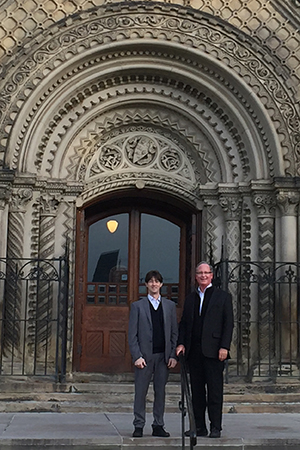This story appeared originally on U of T Engineering News.

"In cities from Toronto to Tokyo, before you undertake a massive infrastructure project such as building a new subway, engineers have to predict how the ground might react to digging a gigantic hole underneath a city of skyscrapers.
Professor Giovanni Grasselli, of the Department of Civil & Mineral Engineering, is a world leader at modelling complex rock formations and predicting how they might respond to physical force. His work could be applied to predicting how drilling a new downtown relief subway line in Canada’s largest city could affect the stability of the rock underneath Torontonians’ feet.
“Toronto is sitting on shale rock, so any underground construction or tunnelling that is done in the city could benefit from a deeper understanding of this type of ground,” Grasselli said. “Whenever there is a disturbance to the rock mass, the risk of failures, including local instabilities and induced seismic shaking, increases so a greater understanding of how a region’s geology will behave can better inform our policy makers.”
Grasselli was recently named the inaugural recipient of the newly established Foundation CMG Research Chair in Fundamental Petroleum Rock Physics and Rock Mechanics, a research chair worth $1.35 million over five years.
His work is of profound interest to industry, as his imaging and modelling techniques help minimize the environmental impact of natural resource extraction processes.

“With better research, and fewer unknowns, we can avoid unnecessary environmental damage,” said Grasselli. “This Chair allows us to produce a strong body of research and develop technology for smarter unconventional petroleum production, which ultimately has the potential to contribute billions of dollars to the Canadian economy, all the while reducing the environmental impacts.”
Using innovative experimentation with X-rays, CT and MicroCT imaging, combined with computer simulations, his research group is generating better understand how spatial geometry and heterogeneity of reservoir rock formations will affect the efficiency of hydrocarbon production.
“We are excited to add Professor Grasselli and the University of Toronto to the FCMG ‘family,’ ” said Duke Anderson, president of Foundation CMG. “Our strategy is to work collaboratively with leading universities around the world, with the petroleum industry and various levels of government in the advancement of reservoir simulation.”
Foundation CMG is a not-for-profit organization that supports world-leading research and development to encourage innovation and leading-edge study into oil and gas reservoir modelling.
[May 2018 update: the name of the Industrial research chair has been updated to reflect the new name of the industrial partner - the NSERC-Energi Simulation Chair in Fundamental Rock Physics and Rock Mechanics]